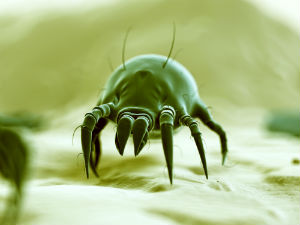
Dust mites are tiny, eight-legged arthropods that invade your home and nourish themselves on the dust flakes of human skin. Not only are they an annoying indoor pest, they can cause us some health issues. Barely visible to the naked eye, dust mites are found in untidy and seemingly clean homes alike. Wherever there's dust, even a little, are dust mites. Fortunately, there are ways to reduce their presence as well as the health concerns associated with them.
The Health Concerns Dust Mites Cause Us
Millions of people are exposed to dust mites every day, with mattresses, bedding, and furniture the most common places these pests reside. People with asthma may find that their symptoms worsen when exposed to dust mites. For these folks, exposure, especially chronic, is going to severely impact their quality of life.
Research has shown that asthmatic children, when exposed to dust mites and other allergens, face the most serious risks. [1] Dust mites are recognized as one of the most common indoor allergens. Dust mite allergies cause eye redness and watering, sneezing, coughing, wheezing, and skin irritation. [2]
Eczema, or atopic dermatitis, is one of the common concerns resulting from dust mite exposure. One study showed that people with eczema were prone to having more mites on their skin. Many patients with atopic dermatitis are advised to maintain a clean, dust-free home (as much as possible). [3]
How to Reduce Dust Mites in Your Home
In order to reduce the frequency of allergic or asthmatic symptoms related to dust mites, there are a few things you should do. While basic cleanliness is enormously important, be sure to implement these simple, effective strategies too.
Reduce Humidity
Dust mites thrive in humid environments, so it is best to keep your home at less than 50% humidity. [4] Dehumidifiers are effective and inexpensive. In dry climates, opening the windows can also help release excess humidity in the home.
Clean!
As their name implies, dust mites thrive in the presence of dust. When dusting your home, use a wet cloth or mop. Be wary of using a traditional duster, as it’s likely to just stir the dust around the home without actually picking it up. Cleaning carpets, or eliminating them completely, can also be a huge help. Your bed is a huge dust mite magnet so wash your bedding at least once a week to reduce dust mite accumulation.
Purchase an Air Filter
Nearly everyone can benefit from a high-quality air filter, especially since it’s not just dust mites you need to be concerned with. HEPA air filters remove more than dust mites, they also remove a lot of the most concerning environmental toxins that are floating around.
Zap Them
I'm not a big fan of microwaves but they do have one good use – they kill dust mites. One study showed that 300 seconds of microwaving on high and medium settings reduced 100% of exposed mites. Popping your child's toy – one that is microwave safe, of course – in the microwave may be a helpful way of reducing your child's exposure to dust mites. [5]
Protect Yourself
Herbal approaches for supporting resistance to the health effects of dust mites have been studied intensely throughout the past few years. Lemongrass and neem seed extract have demonstrated effective results for combating dust mites, not to mention other harmful organisms. [6] Using a product like Global Healing's Lung Health may also be helpful for easing the unpleasant effects that are common with dust mite exposure.
References (6)
- Gent JF, Kezik JM, Hill ME, Tsai E, Li DW, Leaderer BP. Household mold and dust allergens: exposure, sensitization and childhood asthma morbidity. Environmental Research. 2012 October;118:86-93. doi: 10.1016/j.envres.2012.07.005.
- Bush RK. Does allergen avoidance work? Immunology and Allergy Clinics of North America. 2011 August;31(3):493-507. doi: 10.1016/j.iac.2011.05.005.
- Teplitsky V, Mumcuoglu KY, Babai I, Dalal I, Cohen R, Tanay A. House dust mites on skin, clothes, and bedding of atopic dermatitis patients. International Journal of Dermatology. 2008 August;47(8):790-5. doi: 10.1111/j.1365-4632.2008.03657.x.
- Arlian LG, Neal JS, Morgan MS, Vyszenski-Moher DL, Rapp CM, Alexander AK. Reducing relative humidity is a practical way to control dust mites and their allergens in homes in temperate climates. Journal of Allergy and Clinical Immunology. 2001 January;107(1):99-104.
- Ernieenor FC, Ho TM. Effects of microwave radiation on house dust mites, Dermatophagoides pteronyssinus and Dermatophagoides farinae (Astigmata: Pyroglyphidae). Southeast Asian Journal of Tropical Medicine and Public Health. 2010 November;41(6):1335-41.
- Hanifah AL, Awang SH, Ming HT, Abidin SZ, Omar MH. Acaricidal activity of Cymbopogon citratus and Azadirachta indica against house dust mites. Asian Pacific Journal of Tropical Biomedicine. 2011 October;1(5):365-9. doi: 10.1016/S2221-1691(11)60081-6.
†Results may vary. Information and statements made are for education purposes and are not intended to replace the advice of your doctor. If you have a severe medical condition or health concern, see your physician.






